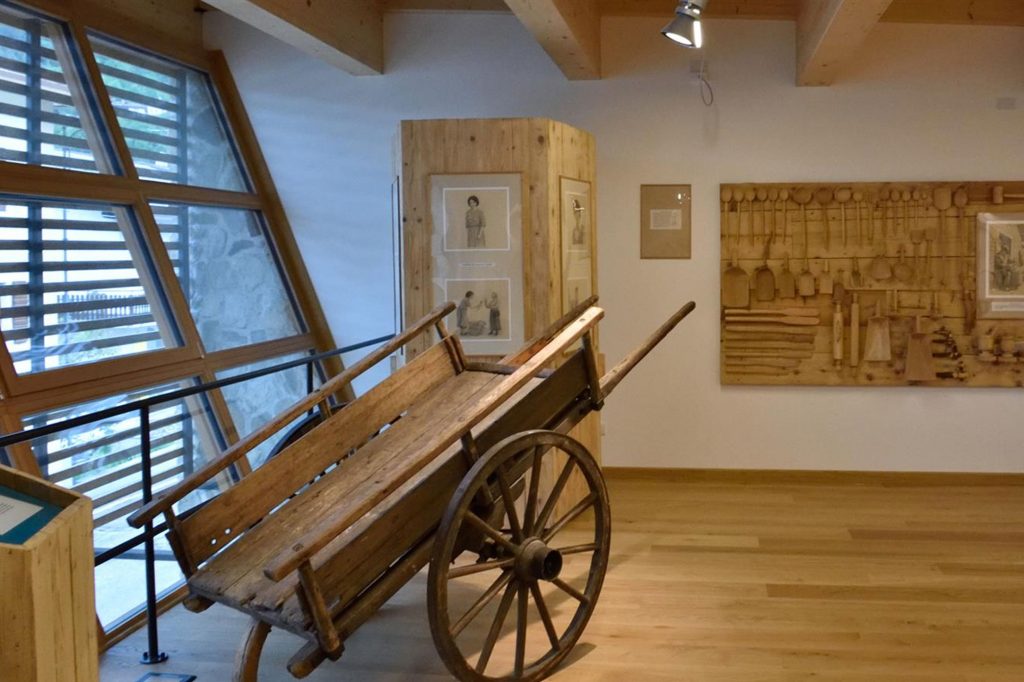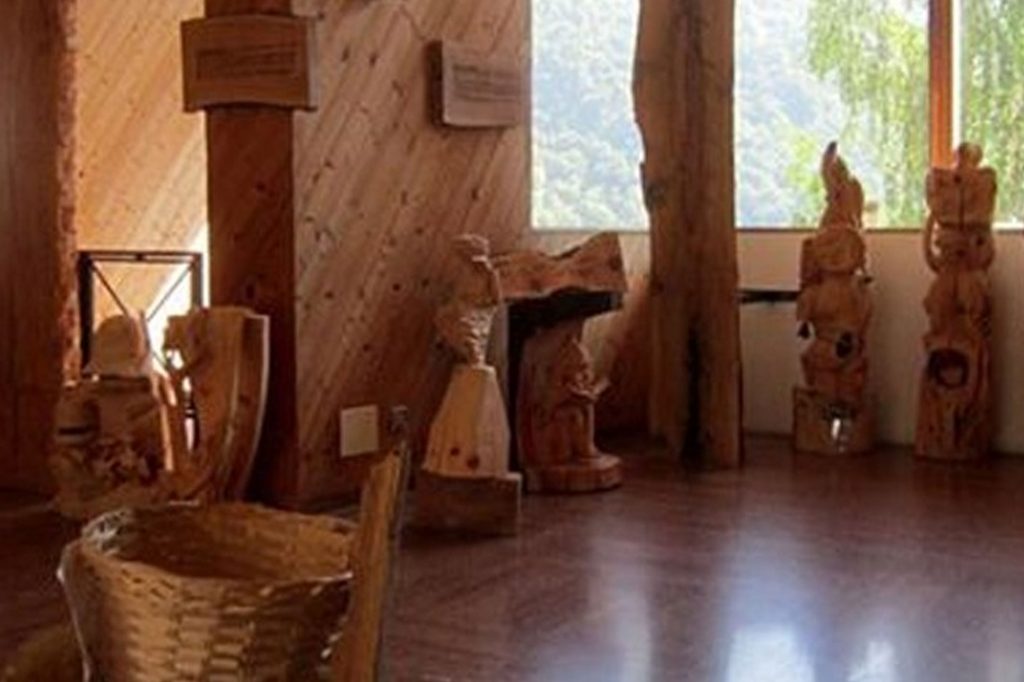MUSEI ED ECOMUSEI
Home | Live the Park | Musei ed Ecomusei

Ethnographic Museum of Andreis
The Ethnographic Museum of Andreis, open to the public since 1981, provides evidence through the exhibition of objects and an environmental reconstruction daily life’s aspects of Andreis’ inhabitants in the first half of the twentieth century. Specifically, we can observe the reconstruction of a typical kitchen of the early ‘900 with the inevitable fireplace and a cjantonâl (corner cabinet used both as a table and closet for food supplies, dishes and cutlery) as well as the reconstruction of the dairy, where it took place the production of butter and cheese. Particular importance is given to the crafts of the past, from the peculiar bone processing to produce snuffboxes and combs to the more traditional wood for the production of footwear and household utensils, from mowing activities to the lumberjacks’ works such as the cutting and transportation of timber downstream. Cultural traditions are also shown in the spaces dedicated to the Carnival and Lent. The Favria of the village, striking blacksmith’s workshop, is located near the Etnographic Museum of Andreis. It was donated by the family of Barba Anzal, the blacksmith who worked there iron and it still preserves all the original equipment.
Opened in the summer on Saturday afternoons and Sundays.

Camminare… c’è una serie infinita di passi… c’è una donna che cammina. Simbolo del Museo non è un oggetto. Non a caso si dà l’idea dell’andare. Il Museo diviene luogo di gesti. Immagine chiave è un’azione di donna, è una favola antica: la clautana fòra pal mónt.
The Museum House Clautana focuses on life in the past, the protagonist is the woman of Claut and, by extension, of Valcellina. The woman intent on the housework, in the fields, in the barn and on as street vendor of wooden tools built by craftsmen during the winter: all these tasks involve even who is totally strange to the local culture: the vision of this cross section of existence causes a comparison between life at that time and now, to reflect on time, events, the technological development, the importance of social values.
The visitor can catch a broader meaning in a really poor in material goods but rich in consistency, dignity, security in the choices of life.
L’allestimento museale è stato recentemente trasferito presso i locali del Centro visite di Claut. Parte integrante e sostanziale del Museum House Clautana è la Ciasa da Fum, abitazione risalente a quattro secoli fa che l’Associazione Museo Casa Clautana ha acquisito e restaurato, mantenendo intatte le caratteristiche architettoniche esterne ed interne.
Opened in summer, on Sunday afternoons.

È il legno il filo conduttore del museo che custodisce la storia del paese. Legno che diventa giocattolo, culla e suole delle scarpe nella mostra dedicata al bambino.
Oggetto da vendere, carretto e cassettiera sulle spalle dei coraggiosi venditori ambulanti nel percorso tematico “Partire partirò partir bisogna…”.
Arte nelle opere lignee del Simposio di scultura che celebrano la continuità di vita dopo l’anniversario della catastrofe del Vajont e che dividono lo spazio con una selva in miniatura di tronchi.
Mauro Corona has given voice to the trees in the audio-sound path accessible with the sensory headphones.
The enchantment of the woods of Erto then reveals itself through “The magic of the wood becomes charcoal”, exhibition dedicated to the ancient craft of the charcoal burner.
Open on Sundays throughout the year.
Mostre:
- “Partire partirò partir bisogna…”,
- “Frammenti di memoria”,
- “L’arte scultorea”,
- “Voci del Bosco”
- “La magia del legno che diventa carbone”

Rural Museum of Forni “Casina da Vic”
The “Casina da Vic”, Vico’s Diary, was opened on the 4thof June 2011; it displays the hardness of living that mountain community endures, its highly rural reality and all tis nuances.
The large building was erected in the 1886, and it is a significant economic and cultural resource, an asset of knowledge and dignity, a treasure trove where the “D.N.A.” of Forni di Sopra lies.
It tells us how important the historical memory, the heritage, the legacy, the roots and the history are. It tells us of culture, sense of togetherness, cooperation, common good, sense of belonging. Its walls, filled with the identity of Forni, enclose a sort of temple of the society, aimed to explain what it means to be a mountaineer. That is why the “Casina” helps us to reflect on the loss of an entire world and of a potential future. It reminds us how important is for the mountain the bond with the land and with the linked economy.

Museum “The Thread of Memories”
The recently restored seventeenth century rural house of “Busa” was formerly a dwelling for both people and animals, where along with farming works, there was no lack of work in iron and in textile production.Once opened to the public, the building has been named “Ciasa dai Fornés” and on its basement hosts a permanent exhibition entitled “Il Filo dei Ricordi” -The Thread of Memories-.
Up to the outbreak of the Great World War, the socio-economic life of Carnia’s inhabitants was characterized by two main livelihoods: agriculture and weaving, these two activities were closely interwoven thought the year.
In winter the “Cràmars” (from Gorto e San Pietro) as well as I “Tesseri” or “Tisidous” (from Socchieve and of Tagliamento) moved to the lands of the “Serenissima” – Venice- and of the House of Habsburg. Those craftsmen worked at home and they sourced the raw materials needed for waving directly from nature or other activities: the wool was obtained from the numerous sheep, hemp and flax from land field and the dyes yellow, green and red from vegetables.

Si sviluppa all’aperto e comprende 8 percorsi rappresentati su un’apposita cartina;
inoltre è disponibile una APP che riporta tutte le indicazioni sui percorsi.
- Il nuovo Percorso natura I Sensi delle Dolomiti consente di scoprire i segreti e le particolarità dei boschi delle Dolomiti attraverso il gioco, coinvolgendo tutti i 5 sensi (vista, tatto, udito, olfatto e gusto). Il percorso si sviluppa per 400 metri lungo il “Sentiero dei Bambini” e comprende 20 stazioni in cui gli utenti possono interagire direttamente con la natura. Lungo il percorso è possibile imparare a riconoscere gli alberi e la magia della fotosintesi, utilizzare uno xilofono naturale in legno, camminare scalzi per ritrovare le sensazioni dimenticate, riconoscere le essenze alpine mediante l’olfatto, imitare in diverse forme l’abilità degli animali.
- L’Orto botanico permette di conoscere le caratteristiche, il periodo di raccolta, gli usi in cucina e le curiosità di numerose specie alimentari, officinali, tintorie e mellifere, illustrando così una piccola parte del grande patrimonio fornese, che vanta una varietà di oltre 1500 specie floristiche e che rende questo territorio un vero scrigno di biodiversità.
- Quello dei Palazzi Storici è un percorso affascinante che si sviluppa nelle nelle 3 borgate di Vico, Cella ed Andrazza, permettendo un salto nel passato, attraverso i portali delle abitazioni delle casate fornesi più importanti, con racconti di vita, mestieri e curiosità storiche.
- I muri parlanti è un percorso costituito dalle pitture murali del professor Marino Spadavecchia che tra il 1973 e 2004, dopo una vita trascorsa a Trieste, Perù e Venezuela, ha impreziosito le case raccontando le storie e i mestieri dei suoi abitanti. È una mostra pittorica all’aria aperta che si sviluppa lungo 13 “muri parlanti”, dal centro paese fino alla frazione Cella, passando per la località di Tiviei.
- Il percorso dedicato all’Energia conduce agli impianti per la produzione sostenibile di energia iniziata a Forni di Sopra oltre un secolo fa, con le prime centrali idroelettriche. Si tratta di una grande centrale a biomassa e di un moderno impianto fotovoltaico a basso impatto, grazie ai quali gli abitanti del paese di Forni possono dire di avere l’auto-sufficienza energetica senza emissioni inquinanti.
- Il percorso dei Musei, Fornaci e Castelli parte dal misterioso sito archeologico del Castello medievale di Sacuidic e passando per musei, preziose chiese, borghi rurali e ponti, giunge all’antica Fornace di Davâras. Si tratta di un itinerario di grande interesse per scoprire le tradizioni e i luoghi che hanno contribuito a creare la storia della nostra comunità.
- Le Vie dell’Acqua sono suggestivi percorsi che dal cuore del paese si sviluppano lungo il fiume Tagliamento, raccontando come la storia e la morfologia di un territorio vengono costantemente disegnate dall’acqua. Lungo gli itinerari si è accompagnati dai suoni dei numerosi torrenti, “fontanas” e “fontanons”, cascatelle e pozzi artesiani, alla scoperta dell’elemento chiave della vita e risorsa preziosa per l’ambiente e la comunità.
- Il percorso dedicato alle Creature Fantastiche è un lungo giro alla scoperta di tredici personaggi fantastici; le tabelle che lo arricchiscono che ne raccontano la storia, le caratteristiche e le leggende, immersi nella natura fiabesca della montagna.

